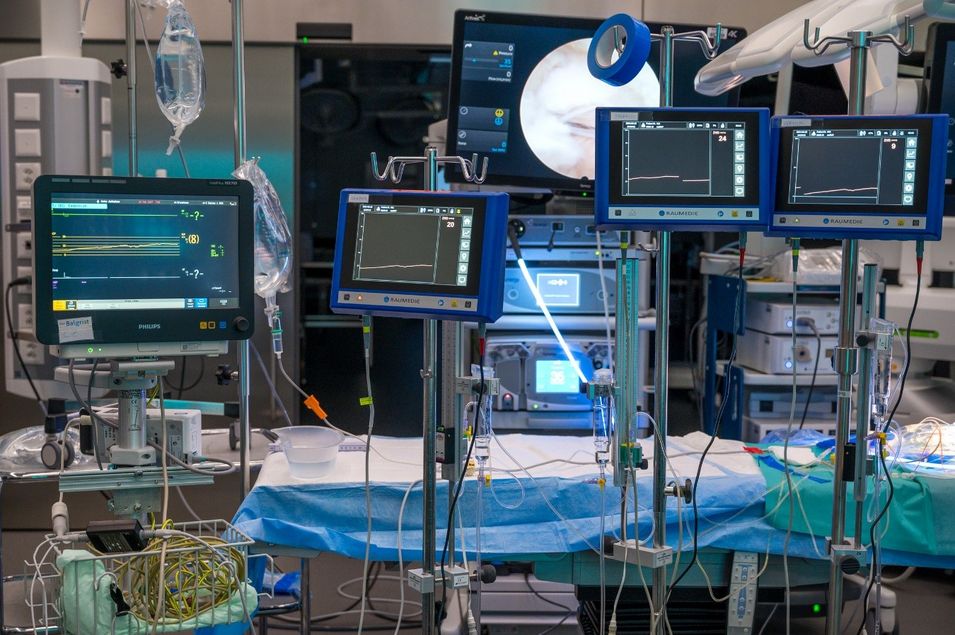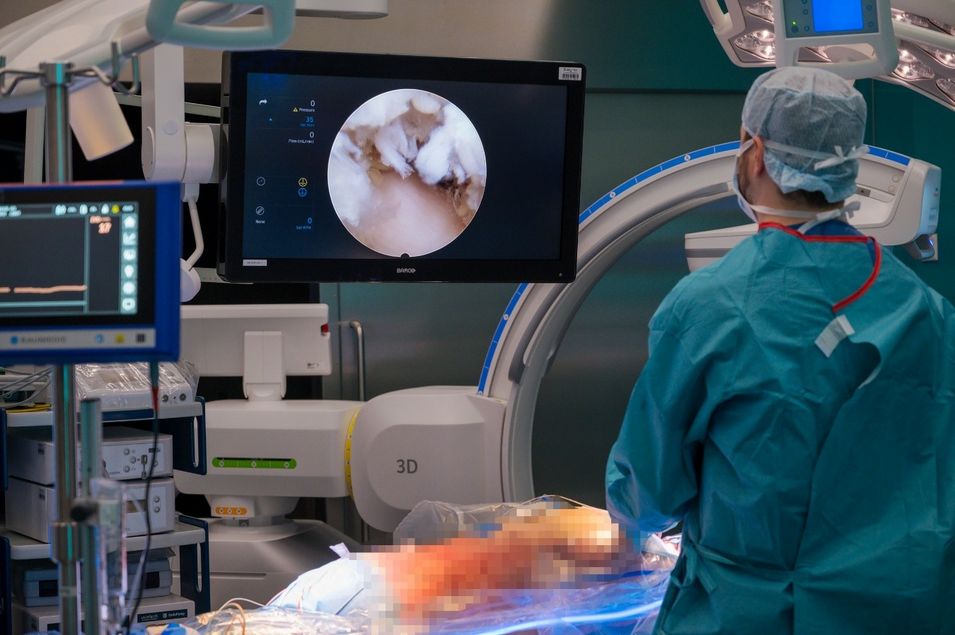Research in Orthopedics
Exploration of Fluid Dynamics During Full Endoscopic Spine Surgery
Endoscopic spine surgery is the most emerging technique of minimally invasive spine surgery. However, it is hypothesized that pressure elevation through fluid irrigation may contribute to adverse events. Our team of researchers set itself the goal of shedding light on the dark area of fluid dynamics in spinal endoscopy.
Minimally invasive surgery is an emerging technique in many orthopedic fields. Endoscopic spine surgery represents the most advanced form of minimally invasive spine surgery in this regard. A camera and instruments are advanced using a keyhole approach, which enables the surgical ”footprint” to be reduced to a minimum, with less soft tissue trauma. To enable optimal visualization, however, the surgical field must be filled with irrigation fluid, which may increase local pressure in the closed system of the spinal canal. Postoperative complications such as seizures, impaired vision, and headaches may arise following the surgical procedure. Could these symptoms be linked to alterations in intraspinal or intracranial pressure induced by the continuous irrigation applied during surgery? This technique is increasingly being performed at Balgrist University Hospital. The safety of irrigation pressures is, however, not well understood as a result of the scarcity of worldwide research in this area. Our team of researchers therefore set itself the goal of shedding light on the dark area of fluid dynamics in spinal endoscopy.

intracranial pressure. Endoscopy tower and screen in the background.

An interdisciplinary team of spinal surgeons, engineers, neurologists, and physiologists developed an innovative experimental setup. This was designed to replicate the conditions of endoscopic surgery and its effect on intraspinal and cranial fluid dynamics in human cadavers. Experiments were performed in Operating Room X (OR-X) at Balgrist University Hospital, a cutting-edge surgical theater and hub for translational surgery enabling the surgical environment used for spinal endoscopy to be reconstructed exactly. As a first step, catheters, which are able to sense pressure changes, were introduced into the spinal canal and carefully advanced to various levels along the spinal axis up to the head.
These catheters enable continuous measurement of intraspinal pressure at lumbar, thoracic, and cervical levels, providing invaluable insights into pressure fluctuations during endoscopic procedures. As the endoscopic procedures were performed, pressure changes were monitored continuously, revealing patterns and fluctuations across different anatomical sites under different pressures applied in the course of the surgical procedure. The nature of the experiment meant that we had the opportunity to perform various spinal endoscopy techniques and to test their limits and consequences for the patient. We are not able to test this scenario during real surgery. What happens if we double or even triple pump pressure? What pressures are safe for the patient? We were able to use the setup described above to measure a correlation between increasing pump pressures and intraspinal pressures reliably over the whole spinal axis up to the head. This allows us to prove our hypothesis.
Our experiment enabled a precise and repeatable depiction of pressure dynamics during endoscopic surgery, showcasing the feasibility of our experimental setup in capturing subtle changes in intraspinal, epidural, and intracranial pressures. With this setup, we are the first to demonstrate that it is indeed possible to measure and analyze intraspinal pressure variations during spinal endoscopy with precision and sensitivity. This study paves the way for future investigations aimed at elucidating the effects of endoscopic techniques and irrigation parameters on intraspinal- and cranial pressure dynamics with the final goal of setting safety standards for spinal endoscopy worldwide.
Flüssigkeitsdynamik während endoskopischer Wirbelsäulenoperationen
Die minimalinvasive Wirbelsäulenchirurgie, speziell die endoskopische Technik, ist auf dem Vormarsch, da sie den chirurgischen Fussabdruck auf ein Minimum und damit Komplikationen reduziert. Allerdings erfordert die Endoskopie das Füllen des Operationsfelds mit Spülflüssigkeit, was den Druck im Wirbelkanal erhöhen und damit postoperative Komplikationen wie Krampfanfälle, Sehstörungen und Kopfschmerzen verursachen kann. Die zunehmende Anwendung dieser Technik in der Universitätsklinik Balgrist und die globale Forschungslücke bei den Sicherheitsaspekten der Spüldrücke haben unser Forschungsteam veranlasst, die Flüssigkeitsdynamik in der spinalen Endoskopie zu untersuchen. Ein interdisziplinäres Team entwickelte ein experimentelles Set-up, um die endoskopische Wirbelsäulenchirurgie und ihre Auswirkungen auf die intraspinale und kraniale Flüssigkeitsdynamik an menschlichen Körperspendern zu simulieren. In diesem Set-up wurden Druckschwankungen während der Operation durch in den Wirbelkanal eingeführte Katheter gemessen. Diese Versuche ermöglichten es, die Beziehung zwischen erhöhten Pumpendrücken und intraspinalen Drücken zu untersuchen und die Auswirkungen unterschiedlicher Druckniveaus auf den Körper zu bewerten. Unsere Studie bietet neue Einblicke in die Flüssigkeitsdynamik während der endoskopischen Wirbelsäulenchirurgie und trägt dazu bei, die Auswirkungen der endoskopischen Techniken auf den intraspinalen und intrakraniellen Druck zu verstehen. Das Ziel ist es, Sicherheitsstandards für die spinale Endoskopie weltweit zu etablieren und somit die Patientensicherheit zu verbessern.
At a Glance
Endospine — Exploration of Fluid Dynamics During Full Endoscopic Spine Surgery
Key Collaborators
Project lead: Prof. Dr. med. Mazda Farshad, MPH, Dr. med. Alexandra Stauffer
Dr. med. Jana Felicitas Schader
Dr. med. Vincent Hagel
PD Dr. med. Carl Moritz Zipser
Najmeh Kheram
PD Dr. med. José Miguel Spirig
PD Dr. Jonas Widmer
Departments and Partners
Balgrist University Hospital:
University Spine Center Zurich
Spinal Cord Injury Center, Dept. of Neurology and Neurophysiology
Dept. of Orthopedics, Spine Biomechanics
University of Zurich, The Interface Group, Inst. of Physiology
ETH Zurich, Inst. for Biomechanics
Clinical Relevance
This project paves the way for future investigations aimed at elucidating the effects of endoscopic techniques and irrigation parameters on intraspinal- and cranial pressure dynamics with the final goal of setting safety standards in spinal endoscopy worldwide.
